Abstract
A novel polyacrylonitrile (PAN)-based ultrafiltration (UF) hollow-fiber membrane was newly synthesized for nanofiltration (NF) applications. This semi-fully NF hollow-fiber membrane was characterized using a variety of analysis techniques. The membrane exhibited higher negative charge and hydrophilicity and lower surface roughness compared to the pristine UF hollow-fiber membrane. Experiments to study the performance and fouling were simulated under laboratory conditions in a cross-flow system and in–out mode using organic compounds, namely, humic acid and sodium alginate. The removal efficiencies of humic acid and sodium alginate were 65% and 73%, respectively, in the pristine hollow-fiber membrane and 93% and 95%, respectively, in the proposed membrane. The flux decline by natural organic matter was less in the case of the proposed membrane compared to that in the pristine membrane. To mitigate organic fouling on the proposed membrane, sodium hypochlorite (NaClO) was used as a chemical enhanced backwashing agent. At a NaClO concentration of 1 mg/L with a backwashing time of 30 s, an optimal flux recovery of 92.1% of the initial permeability of the PAN-NF hollow-fiber membrane was achieved with less membrane degradation. The results of this study will provide practical insight and act as a technical guide for NF-based plant engineers/operators.
1. Introduction
Filtration using nanofiltration (NF) membranes is a pressure-driven process employed to remove multivalent cations and low-molecular-weight species selectively with low energy consumption [1,2]. Due to their higher water permeability and low osmotic pressure, NF membranes are extensively used instead of reverse osmosis (RO) for water softening, treatment of brackish water, surface water, drinking water, and separation processes in the chemical and pharmaceuticals fields [3,4]. Furthermore, NF membranes are being developed to provide better filtration to separate inorganic and organic substances using fabrication procedures such as interfacial polymerization and using nanoparticles [5,6,7]. However, despite significant advances in NF membrane technology, membrane fouling is a key improvement area for general module types comprising NF membrane geometries such as spiral wound and tubular membranes.
Spiral wound membrane modules consume high energy. Although these membranes do not allow back flushing, they are highly susceptible to fouling caused by suspended solids [8]. Therefore, extensive pretreatment is necessary for these membranes. In contrast, tubular membrane modules are less susceptible to fouling by particulate matter and require facile cleaning approaches; however, they offer packing densities only up to 800 m2/m3, while spiral wound membranes offer packing densities up to 1000 m2/m3 [9]. In recent years, hollow-fiber (HF) membranes with various benefits over both spiral wounds and tubular modules have been reported; compared to the previous two modules, HF membranes have higher fouling resistance [10], higher packing density [9], lower requirements of pretreatment and maintenance, and higher volumes of permeate [11], which allow for the direct treatment of drinking water resources. However, the development of an HF NF membrane with high separation selectivity is crucial for drinking water treatment.
Many researchers have found that physical backwashing can enhance membrane performance as it results in a higher cleaning efficiency with respect to particulate matter and colloids [12,13,14]. However, organic fouling can be hardly controlled during physical backwashing in HF membranes [15,16]. Some of the main chemical cleaning methods used for mitigating membrane organic fouling are cleaning in place (CIP) and chemical enhanced backwashing (CEB) [17]. CIP is a more efficient fouling control method than CEB due to its higher cleaning agent concentrations and soak temperatures, high treatment costs, and low operation efficiency [18]. In recent applications of drinking water treatment systems involving chemical cleaning, sodium hypochlorite (NaOCl) was found to be the most common oxidant for organic-fouling control during membrane cleaning because it effectively restores membrane permeability and is relatively less environmentally hazardous compared to other chlorine-based chemicals [18,19]. Intensive CEB, in terms of both frequency and concentration of the chemical reagent, may enable long-term operation of membrane processes for water and wastewater treatment [20].
During long-term operation using a membrane separation system, the optimization of chemical cleaning is essential to reduce the operating cost [21]. Some important factors to be considered when applying NaClO-assisted CEB technology in pressure-driven membrane cleaning are flushing time, backwashing time, backwashing repeating frequency, chemical dosage, chemical cleaning times, and chemical cleaning repeating frequency. Wang et al. reported the effective control of fouling during CEB at high backwashing frequencies using NaClO concentrations of 0.5–1.5 mg/L with the minimum adverse effect on bacterial communities in membrane bioreactors (MBRs) [22]. Jiang et al. found that the function of NaClO-assisted CEB could be correlated to the polysaccharide in foulants for the in situ application of CEB in anammox MBR [23]. However, few attempts have been made to examine NaClO-assisted CEB associated with HF NF performance in drinking water treatment plants. Previous studies have provided a preliminary indication regarding the potential of employing the NaClO-assisted CEB technique for NF membrane cleaning.
In this study, a novel thin-film composite (TFC) HF NF membrane was fabricated to remove natural organic compounds from the surface water. To the best of our knowledge, this is the first attempt to subject HF NF membranes to CEB for membrane fouling control. Physical and chemical cleaning methods, membrane surface morphology, and water quality analyses were systematically performed to assess the impact of organic foulants. In addition, we intended to optimize the CEB process using NaClO to minimize the negative impact of NaClO on membrane properties and perform fewer pretreatment processes to achieve high fouling control with low investment and operational costs in real water treatment plants.
2. Materials and Methods
2.1. PAN-NF HF Membrane
Figure 1 presents the fabrication protocol of the HF polyacrylionitrile (PAN) NF membrane (Synopex, Pohang, South Korea). First, the pristine PAN-UF support was impregnated with an amide aqueous solution for 10 min, and the excess amide solution was removed using a rubber roller (Sigma Aldrich, St. Louis, MO, USA). The amide aqueous solution was made by dissolving 1–4% w/v piperazine (PIP, Sigma Aldrich, St. Louis, MO, USA), 0.5–2% w/v triethylamine (Sigma Aldrich, St. Louis, MO, USA), and 0.5–2% w/v polyvinyl alcohol (Sigma Aldrich, St. Louis, MO, USA) in deionized (DI) water. Subsequently, a trimesoyl chloride (TMC 0.05–0.4% w/v, Sigma Aldrich, St. Louis, MO, USA) solution in toluene (Sigma Aldrich, St. Louis, MO, USA) was poured on the PIP-saturated PAN support and allowed to react for 3 min to form a polyamide (PA) selective layer. The prepared PAN-NF membrane was then rinsed with pure toluene to remove unreacted TMC, and then dried at 70 °C for 3 min. Subsequently, the PAN-NF HF was modulated with a stainless steel pipe. After full curing (3 h), the single PAN-NF HF module was stored in distilled water until utilization. The module characteristics, operating conditions and SEM morphologies of the PAN-NF HF membrane are listed in Table S1 and Figure S1.

Figure 1.
Preparation of the hollow-fiber (HF) polyacrylionitrile (PAN) nanofiltration (NF) membrane.
2.2. Analysis of Organic Compounds
Humic acid (HA) and sodium alginate (SA) were purchased from Sigma-Aldrich (St. Louis, MO, USA) and used as single-feed water solutions for the filtration experiment. To examine the applicability of the membrane for water treatment under actual conditions, the feed concentrations of both the solutions with natural organic matter (NOM) used in this experiment were 5 mg/L. To achieve the required feed concentration of the NOM, stock solutions were prepared and diluted using deionized ultrapure water and then filtered using 0.45 μm filters (Millipore Inc., Burlington, MA, USA).
An Ultraviolet–Visible (UV–Vis, absorbance at 254 nm) spectrophotometer (DR5000, HACH, Loveland, CO, USA) was used to measure the concentration of humic substances, and a total organic carbon (TOC) analyzer (Schimadzu 5000A, Kyoto, Japan) was used to measure SA concentration for removal efficiency. The concentration of humic substances was determined according to the modified Lowry method [12] by using humic acids (Sigma Inc., St. Louis, MO, USA) as standards. The concentration of total organic carbon (TOC) was determined using a TOC analyzer (TOC-V, Shimadzu, Japan). The pH was adjusted to 7 using 0.1 M HCl and 0.1 M NaOH. The conductivity was adjusted to 300 μS/cm with 0.1 M NaCl.
2.3. Membrane Retention and Fouling Performance
The pure water permeability of the HF membrane was investigated using a cross-flow mode filtration system before investigating the retention performance of the membrane. The filtration system consisted of a membrane with a surface area of 582.0 cm2 and a total volume of 5 L with stirring at 300 rpm (Table S1). The experimental procedure involved three–four cycles of cross-flow filtration. The duration of each cycle was 24 h. The applied pressure was 5 bar for the HA, SA, and real raw water from a domestic water treatment plant in Indonesia. Under these conditions, the pure water flux was 45.0 ± 1.7 L/m2 h for the PAN-NF HF membrane. To confirm the membrane fouling caused by both NOM foulants during filtration, the observed water fluxes were converted into normalized fluxes.
2.4. Physical and Chemical Backwashing
NaClO solution with 12% w/w freely available chloride ions was purchased from Sigma-Aldrich (St. Louis, MO, USA). The concentrations of NaClO used for backwashing in this experiment were 20 and 30 mg/L. Hydraulic backwashing was also performed to compare the efficiencies of chemical and hydraulic backwashing under identical conditions. Each type of backwashing was performed for about 30 s after a cycle at a pressure of 1 bar for HA, SA, and real raw water from a water treatment plant in Indonesia. The cleaning efficiencies under various concentrations of NaClO were assessed in terms of the relative permeability recovery calculated using Equation (1) [24]:
where Rv is the relative permeability recovery; Pac is the permeability after cleaning; Pbc is the permeability before cleaning; and Pv is the initial permeability of the virgin membrane (LMH/bar) [24]. NaClO is known to be an efficient chemical cleaning agent [22,23,24,25,26]. Therefore, low concentrations of NaClO at 1–10 mg/L were used to ensure minimal negative impact on the membrane and to optimize the conditions for water treatment.
2.5. Assessment of Fouling Potential in NF
A newly developed modified fouling index (MFI) approach using a multiple membrane array system was applied to evaluate the fouling potential of RO feed water described in our previous reports [27,28,29,30]. In this method, feed water (i.e., raw water from Indonesia) was first filtered by a microfiltration (MF) membrane to determine the fouling potential of particulate matter larger than 0.45 µm. The permeate obtained from the first MF membrane (0.45 µm, Millipore Corp., Burlington, MA, USA) was then fed to the next ultrafiltration (UF) membrane (100 kDa, Millipore Corp., Burlington, MA, USA) to assess the fouling potential of nanocolloids. Finally, feed water containing mainly organic foulants was introduced into another tight UF membrane (10 kDa, Millipore Corp., Burlington, MA, USA) with a surface area of 0.00138 m2. In this method, feed water was first filtered by a MF membrane to determine the fouling potential of particulate matter larger than 0.45 µm, named as particle-MFI (P-MFI). The permeate obtained from the first MF membrane was then fed to the next UF membrane named by colloid-MFI (C-MFI), which assessed the fouling potential of nano-colloids. Finally, feed water containing mainly organic foulants was introduced to the tight UF membrane by organic-MFI (O-MFI) [28,31].
According to the standard specified by ASTM, the MFI can be described using Equation (2) at dead-end measurements:
where t is the filtration time; V is the filtration volume; ΔP is the applied transmembrane pressure [Pa]; μ is the solution viscosity [Pa∙s]; I is the resistivity [m−2]; Rm is the membrane resistance [m−1]; and A is the membrane surface area [m2] [31,32].
2.6. Characterization of the PAN-NF HF Membrane
The inner surface morphology of the PAN-NF HF membrane was analyzed by high-quality field emission scanning electron microscopy (FE-SEM, Nova-SEM, FEI, Hillsboro, OR, USA). The inner surface charge (zeta potential) of the PAN-NF HF membrane was measured using an electrophoretic apparatus ELS_2000Z (OtsuKa Electronics, Otsuka, Japan) using 10 mM NaCl solution. The water contact angle of the PAN-NF HF membrane was measured by the sessile drop method (Phoenix-300 analyzer with video capturing equipment; SEO Corporation). The results were determined as the average of at least five measurements for each sample.
3. Results and Discussion
3.1. Performance of the PAN-NF HF Membrane
Figure 2 shows the removal levels of NOM (HA and SA) by both the pristine and modified PAN-NF HF membranes. The removal of both organic materials by the modified PAN-NF HF membrane was slightly high: 93% for HA and 95% for SA; in contrast, the pristine membrane removed 65% of HA and 73% of SA. The main mechanisms for removing these contaminants in the PAN-NF HF membranes may be sieving and hydrophobic adsorption. Moreover, the mechanism in the PAN-NF HF membrane may be electrostatic repulsion between the NOM and negatively charged inner PAN membrane. In the observed charge differences (see Supplementary Materials for the zeta potential of the PAN-NF HF membrane, Figure S2), the modified membrane had a strong negative charge (−33.1 mv) at pH 7, whereas the pristine membrane showed a weak negative charge (−14.3 mv); this led to reduced electrostatic repulsion between the NOM and modified membrane, resulting in a higher removal efficiency than that observed in the pristine HF membrane [33,34,35]. In addition, the contact angle values in Figure S3 confirmed that the modified PAN-NF HF membrane exhibited a slightly higher hydrophilicity than the pristine HF membrane. This indicates that the PAN-NF HF membrane has a strong fouling resistance, which leads to reduced membrane fouling [36,37].
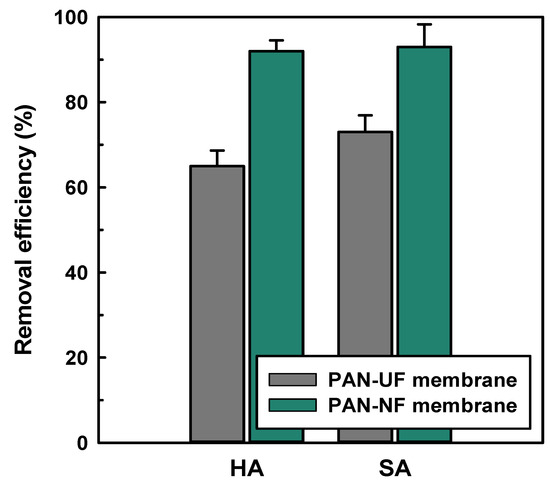
Figure 2.
Removal of natural organic matter (NOM) (humic acid, HA, and sodium alginate, SA) by pristine and modified PAN-NF HF membranes. Operating conditions: HA and SA = 5 mg/L; pressure = 5 bar; stirring speed = 300 rpm; cross-flow velocity = 1 L/min; conductivity = 300 μs/cm; and temperature = 25 °C.
Figure 3 illustrates the permeate flux of pure water and fouling development time. The average pure water flux of the PAN-NF HF membrane was 4.75 LMH/bar prior to the test. Compared to the initial water flux of the membrane, the reductions in the flux in the modified PAN-NF HF membrane were 7.8% for HA and 11.8% for SA and those in the pristine membrane were 11.8% for HA and 16.3% for SA. Previous investigations found that the absence of membrane fouling can be attributed to electrostatic repulsion or/and hydrophobicity [36,38]. The modified PAN-NF HF membrane had a stronger negative charge value than the pristine membrane, leading to increased electrostatic repulsion for NOM contaminants [34,39]. Therefore, the flux decline in the modified PAN-NF HF membrane was less than that in the pristine membrane. The modified PAN-NF HF membrane exhibited lower hydrophobicity than the pristine membrane, leading to less hydrophobic attraction between the NOM and membrane surface or pores [37,40]. This caused less membrane fouling with minimal flux decline.
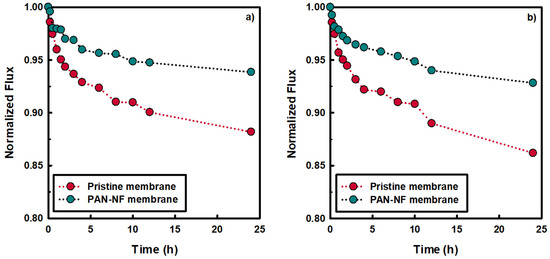
Figure 3.
Normalized permeate flux as a function of time for modified and pristine PAN-NF membranes as a function of time. Operating conditions: (a) HA and (b) SA = 5 mg/L; pressure = 5 bar; stirring speed = 300 rpm; cross-flow velocity = 1 L/min; conductivity = 300 μs/cm; temperature = 25 °C. The permeate and concentrate were recirculated back to the feed tank during filtration.
3.2. Fouling Behavior on the PAN-NF Membrane after Backwashing
3.2.1. Effect of Physical Backwashing on Organic Fouling
Backwashing is commonly utilized in most HF membrane filtration systems to reduce fouling in cross-flow applications [13,41,42,43]. The modified PAN-NF HF membrane was evaluated for organic fouling with HA and SA. Figure 4a indicates the flux recovery of the modified PAN-NF membrane after physical backwashing. The flux recovered by 20% after HA filtration and 10% after SA filtration. The flux recovery efficiency of the PAN-NF HF membrane did not improve because both HA and SA formed a gel-like sticky fouling layer on the membrane surface [44,45]. These types of fouling on the membrane surface possibly reduced the flux performance of the PAN-NF HF membrane, and additional force was required to remove the fouling layer from the membrane surface. Therefore, conventional physical backwashing resulted in a lower backwashing effect, and thus, the flux of the PAN-NF HF membrane was not fully recovered after organic fouling by NOM.
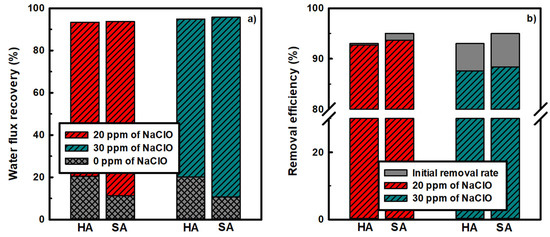
Figure 4.
(a) Water flux recovery of the HA- and SA-fouled PAN-NF HF membrane after backwashing with NaClO solutions of different concentrations compared to water flux recovery using nonchemical backwashing. (b) Removal efficiencies of HA and SA from the PAN-NF HF membrane after backwashing with different concentrations of NaClO.
3.2.2. CEB for Organic-Fouling Control
The performance of chemical backwashing for the modified PAN-NF HF membrane was evaluated because physical backwashing did not help recover the flux performance of the organic-fouled membrane. Earlier studies found that NaClO solutions can negatively affect membrane properties or membrane aging [46,47]. Therefore, in this study, NaClO solutions with low concentrations were used during chemical backwashing of the membrane to achieve optimal membrane permeability recovery with minimum impact on membrane performance [48,49].
Figure 4b shows the removal efficiency results of the experiments performed once a week using different NaClO concentrations. Increasing the concentration of NaClO to 20 and 30 mg/L increased the backwashing efficiency after 60 s of backwashing following seven days of filtration. Backwashing with 30 mg/L of NaClO exhibited the best flux recovery rate of the PAN-NF HF membrane; 95% of both NOM-fouled membranes were recovered. However, the HA and SA removal efficiencies significantly decreased after chemical backwashing at 30 mg/L of NaClO. The removal efficiencies were 87.6% for HA and 88.4% for SA. These results indicate that the properties of the membrane may have deteriorated because of the high concentration of NaClO. Thus, 20 mg/L NaClO was considered appropriate for backwashing the PAN-NF HF membrane. The flux recovery of the PAN-NF HF membrane was efficiently restored through backwashing at 20 mg/L NaClO. Figure 4a indicates that the water flux recoveries of the PAN-NF HF membrane were 93.3% for HA and 93.7% for SA, whereas the removal efficiencies were 92.7% for HA and 93.7% for SA. The PAN-NF HF membrane exhibited stable water permeability after backwashing with 20 mg/L NaClO. As NaClO comprises functional groups such as aldehyde (CHO), carboxyl (COOH), and keto (C=O), these functional groups can deteriorate the mechanical properties of the membrane [50]. As shown in Figure 5, NaClO backwashing of the HF membrane in this experiment provided relatively good recovery of water permeability due to the oxidation and removal of the organic-fouling layer. Although the NaClO solution increased the pore size of the membrane because of the oxidation of the membrane inner surface, it increased the negative charges on the membrane surface, thereby causing an increase in electrostatic repulsion between the negative charges on the membrane and NOM foulants [51]. Moreover, exposure to NaClO increased the hydrophilicity of the inner surface of the membrane. This may increase the interactions between the membrane and both NOM foulants, resulting in stable TOC removal efficiency after NaClO backwashing.
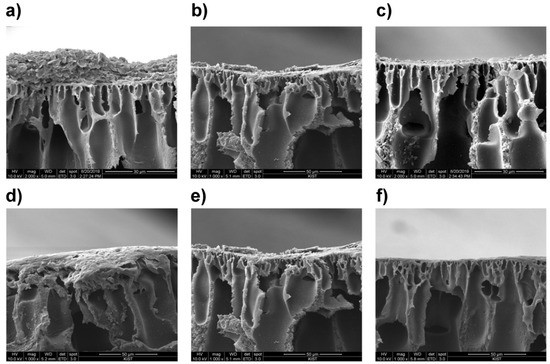
Figure 5.
Scanning electron microscopy (SEM) images of the (a) membrane fouled by HA, (b) HA-fouled membrane after hydraulic backwashing, (c) HA-fouled membrane after NaClO backwashing, (d) membrane fouled membrane by SA, (e) SA- fouled membrane after hydraulic backwashing, and (f) SA-fouled membrane after NaClO backwashing.
3.3. Case Study: Application of NaClO Backwashing in the PAN-NF HF Membrane Used in Domestic Drinking-Water Plants
3.3.1. MFI Value of Feed Water
In this case study, the feed water was collected from an existing water treatment plant in Jakarta, Indonesia. The raw water parameters are listed in Table S2. Samples were stored in a refrigerator below 5 °C without any chemical pretreatment. Figure 6 shows the results of fouling potential variations in raw water and tap water samples with P-MFI values of 41,891 ± 658 and 15 ± 1.2 s/L2, respectively, indicating the high fouling potential of foulants larger than 0.45 µm. In addition, compared to tap water, the significant O-MFI and C-MFI values ranging from 10 kDa to 0.45 µm in size were 28,193 ± 758 and 4857 ± 589 s/L2, respectively; these results reveal that the loading of particulate, colloidal, and organic matter in raw water leads to frequent cleaning operations during the NF process. Furthermore, the main water quality parameters (suspended solids, hardness, and TOC) were monitored using a significantly high concentration of raw water showing high potential for fouling the NF membrane, therefore, further treatment was required before subjecting the water to NF.
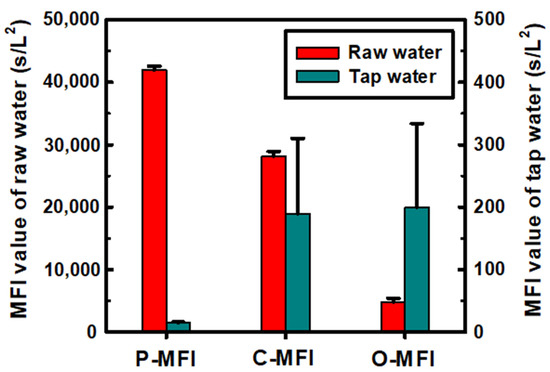
Figure 6.
Fouling potential of water samples in real raw water and tap water.
3.3.2. Application of CEB in the PAN-NF HF Membrane
The developed PAN-NF HF membrane exhibited optimal water recovery with backwashing using 20 mg/L of NaClO in previous laboratory-scale investigations. Hence, 20 mg/L NaClO was used for backwashing during the actual treatment of raw water in this study; it exhibited a permeability recovery of 94.3% of the initial permeability of the membrane. However, the removal efficiency of the PAN-NF HF membrane after backwashing with 20 mg/L NaClO was less than the initial removal efficiency of 93.3% after contamination for the raw water sample. Backwashing was performed with NaClO concentrations of 1 mg/L and 10 mg/L to identify the optimal chemical backwashing concentrations and to reduce the NaClO concentration for higher permeability recovery and stable removal performance in an actual water treatment plant. Figure 7a shows that the water fluxes of the PAN-NF HF membrane recovered to 92.4% and 81.2% of the initial permeability after backwashing with 10 mg/L and 1 mg/L NaClO, respectively. As shown in Figure S4, contaminants on the inner surface of the PAN-NF HF membrane were clearly removed after backwashing with different concentrations of NaClO. However, a slight degradation in the removal efficiency occurred after backwashing with 10 mg/L NaClO. Figure 7b shows that the TOC removal efficiency of the PAN-NF HF membrane after backwashing with 10 mg/L NaClO decreased slightly from 92.3% to 91.3%, while the removal efficiency after backwashing with 1 mg/L NaClO had a stable constant value of 92.1%. In previous studies, higher chemical concentrations were used to remove organic foulants from UF membranes. Furthermore, studies on CEB for NF HF membranes used in water treatment are lacking. Hence, despite the membrane degradation that occurs with low concentrations of NaClO, 1 mg/L NaClO may be the optimal concentration for the chemical backwashing of PAN-NF HF membranes employed in water treatment plants in Indonesia.
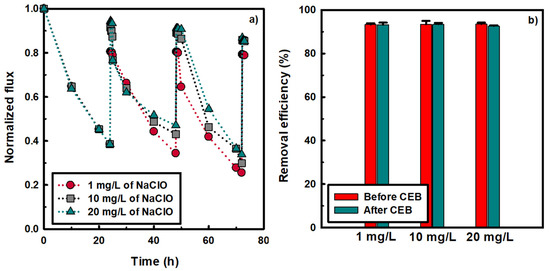
Figure 7.
(a) Normalized permeate flux and flux recovery of the PAN-NF HF membrane during backwashing using different concentrations of NaClO as a function of time. (b) TOC removal efficiency of the PAN-NF HF membrane after backwashing with different concentrations of NaClO. Operating conditions: pressure = 5 bar; stirring speed = 300 rpm; cross-flow velocity = 1 L/min, conductivity = 300 μS/cm; backwashing pressure: 1 bar; backwashing period: 30 s; and temperature = 25 °C.
4. Conclusions
A novel TFC PAN-NF HF membrane was developed to remove natural organic compounds during drinking water treatment. The membrane was modified, based on its physicochemical properties, to obtain a semiaromatic structured membrane and showed superior retention of the target NOM due to its small pore size, large negative charge, and hydrophilicity. Thus, it exhibited good fouling resistance. We further applied CEB to improve the organic-fouling resistance.
NaClO-assisted CEB can remove most particulates and colloids and overcome the problems involved in removing NOM deposited on the membrane. Compared to the initial water flux of the PAN-NF membrane, the permeability recoveries after NaClO backwashing were 93.3% for HA and 93.7% for SA. Furthermore, the removal efficiencies after NaClO backwashing were 92.7% and 93.7% for HA and SA, respectively. We concluded that the NaClO concentration of 1 mg/L with a backwashing time of 30 s can be selected as the optimal chemical backwashing agent in actual HF NF water treatment applications. We expect that the accumulation of field data on NF using different real surface waters will contribute greatly toward the development of operational guidelines on NF plants and their operation.
Supplementary Materials
The following are available online at https://www.mdpi.com/article/10.3390/app11156764/s1, Figure S1: Scanning electron microscopy (SEM) morphologies, Figure S2: Zeta potential of PAN-NF HF membrane, Figure S3: Contact angle measurements, Figure S4: Application of CEB in the PAN-NF HF membrane; Table S1: Membrane module characteristics and operating conditions, Table S2: Parameters of raw water samples from a water treatment plant at Jakarta, Indonesia.
Author Contributions
Conceptualization, H.K.; Methodology, H.K.; Software, H.K.; Validation, M.Z.; Investigation, H.K. and I.S.; Resources, H.K.; Data curation, H.K. and I.S.; Writing-original draft preparation, H.K. and M.Z.; Writing-review and editing, M.Z.; Visualization, H.K. and M.Z.; Supervision, M.Z.; Project administration, H.K. All authors have read and agreed to the published version of the manuscript.
Funding
This research was funded by the KOREA ENVIRONMENT INDUSTRY & TECHNOLOGY INSTITUTE (KEITI) through the Public Technology Program based on Environmental Policy, funded by the Korean Ministry of Environment (grant number 2018000700001).
Data Availability Statement
The data presented in this study are available in the Supplementary Materials.
Conflicts of Interest
The authors declare no conflict of interest.
References
- Diawara, C.K. Nanofiltration process efficiency in water desalination. Sep. Purif. Rev. 2008, 37, 302–324. [Google Scholar] [CrossRef]
- Sun, S.P.; Hatton, T.A.; Chan, S.Y.; Chung, T.-S. Novel thin-film composite nanofiltration hollow fiber membranes with double repulsion for effective removal of emerging organic matters from water. J. Membr. Sci. 2012, 401–402, 152–162. [Google Scholar] [CrossRef]
- Nataraj, S.K.; Hosamani, K.M.; Aminabhavi, T.M. Nanofiltration and reverse osmosis thin film composite membrane module for the removal of dye and salts from the simulated mixtures. Desalination 2009, 249, 12–17. [Google Scholar] [CrossRef]
- Fang, W.; Shi, L.; Wang, R. Interfacially polymerized composite nanofiltration hollow fiber membranes for low-pressure water softening. J. Membr. Sci. 2013, 430, 129–139. [Google Scholar] [CrossRef]
- Ang, M.B.M.Y.; Ji, Y.-L.; Huang, S.-H.; Lee, K.-R.; Lai, J.-Y. A facile and versatile strategy for fabricating thin-film nanocomposite membranes with polydopamine-piperazine nanoparticles generated in situ. J. Membr. Sci. 2019, 579, 79–89. [Google Scholar] [CrossRef]
- Rafique, R.F.; Min, Z.; Son, G.; Lee, S.H. Removal of cadmium ion using micellar-enhanced ultrafiltration (MEUF) and activated carbon fiber (ACF) hybrid processes: Adsorption isotherm study for micelle onto ACF. Desalin. Water Treat. 2016, 57, 7780–7788. [Google Scholar] [CrossRef]
- Li, T.; Xiao, Y.; Guo, D.; Shen, L.; Li, R.; Jiao, Y.; Xu, Y.; Lin, H. In-situ coating TiO2 surface by plant-inspired tannic acid for fabrication of thin film nanocomposite nanofiltration membranes toward enhanced separation and antibacterial performance. J. Colloid Interface Sci. 2020, 572, 114–121. [Google Scholar] [CrossRef] [PubMed]
- Frank, M.; Bargeman, G.; Zwijnenburg, A.; Wessling, M. Capillary hollow fiber nanofiltration membranes. Sep. Purif. Technol. 2001, 22–23, 499–506. [Google Scholar] [CrossRef]
- García-Fernández, L.; Khayet, M.; García-Payo, M. Membranes Used in Membrane Distillation: Preparation and Characterization. In Pervaporation, Vapour Permeation and Membrane Distillation, 1st ed.; Basile, A., Figoli, A., Khayet, M., Eds.; Elsevier: Cambridge, UK, 2015; pp. 317–359. [Google Scholar]
- Liu, T.-Y.; Bian, L.-X.; Yuan, H.-G.; Pang, B.; Lin, Y.-K.; Tong, Y.; Van der Bruggen, B.; Wang, X.-L. Fabrication of a high-flux thin film composite hollow fiber nanofiltration membrane for wastewater treatment. J. Membr. Sci. 2015, 478, 25–36. [Google Scholar] [CrossRef]
- Di Profio, G.; Ji, X.; Curcio, E.; Drioli, E. Submerged hollow fiber ultrafiltration as seawater pretreatment in the logic of integrated membrane desalination systems. Desalination 2011, 269, 128–135. [Google Scholar] [CrossRef]
- Choi, B.G.; Zhan, M.; Shin, K.; Lee, S.; Hong, S. Pilot-scale evaluation of FO-RO osmotic dilution process for treating wastewater from coal-fired power plant integrated with seawater desalination. J. Membr. Sci. 2017, 540, 78–87. [Google Scholar] [CrossRef]
- Chang, H.; Liang, H.; Qu, F.; Liu, B.; Yu, H.; Du, X.; Li, G.; Snyder, S.A. Hydraulic backwashing for low-pressure membranes in drinking water treatment: A review. J. Membr. Sci. 2017, 540, 362–380. [Google Scholar] [CrossRef]
- Zhan, M.; Gwak, G.; Kim, D.I.; Park, K.; Hong, S. Quantitative analysis of the irreversible membrane fouling of forward osmosis during wastewater reclamation: Correlation with the modified fouling index. J. Membr. Sci. 2020, 597, 117757. [Google Scholar] [CrossRef]
- Liang, H.; Gong, W.; Chen, J.; Li, G. Cleaning of fouled ultrafiltration (UF) membrane by algae during reservoir water treatment. Desalination 2008, 220, 267–272. [Google Scholar] [CrossRef]
- Kweon, J.H.; Jung, J.H.; Lee, S.R.; Hur, H.W.; Shin, Y.; Choi, Y.H. Effects of consecutive chemical cleaning on membrane performance and surface properties of microfiltration. Desalination 2012, 286, 324–331. [Google Scholar] [CrossRef]
- Porcelli, N.; Judd, S. Chemical cleaning of potable water membranes: A review. Sep. Purif. Technol. 2010, 71, 137–143. [Google Scholar] [CrossRef] [Green Version]
- Bogati, R.; Goodwin, C.; Marshall, K.; Leung, K.T.; Liao, B.Q. Optimization of chemical cleaning for improvement of membrane performance and fouling control in drinking water treatment. Sep. Sci. Technol. 2015, 50, 1835–1845. [Google Scholar] [CrossRef]
- Regula, C.; Carretier, E.; Wyart, Y.; Gésan-Guiziou, G.; Vincent, A.; Boudot, D.; Moulin, P. Chemical cleaning/disinfection and ageing of organic UF membranes: A review. Water Res. 2014, 56, 325–365. [Google Scholar] [CrossRef] [PubMed]
- Lateef, S.K.; Soh, B.Z.; Kimura, K. Direct membrane filtration of municipal wastewater with chemically enhanced backwash for recovery of organic matter. Bioresour. Technol. 2013, 150, 149–155. [Google Scholar] [CrossRef] [Green Version]
- Hacıfazlıoğlu, M.C.; Parlar, İ.; Pek, T.Ö.; Kabay, N. Evaluation of chemical cleaning to control fouling on nanofiltration and reverse osmosis membranes after desalination of MBR effluent. Desalination 2019, 466, 44–51. [Google Scholar] [CrossRef]
- Wang, Z.; Meng, F.; He, X.; Zhou, Z.; Huang, L.N.; Liang, S. Optimisation and performance of NaClO-assisted maintenance cleaning for fouling control in membrane bioreactors. Water Res. 2014, 53, 1–11. [Google Scholar] [CrossRef] [PubMed]
- Jiang, C.K.; Tang, X.; Tan, H.; Feng, F.; Xu, Z.M.; Mahmood, Q.; Zeng, W.; Min, X.B.; Tang, C.J. Effect of scrubbing by NaClO backwashing on membrane fouling in anammox MBR. Sci. Total Environ. 2019, 670, 149–157. [Google Scholar] [CrossRef]
- Porcelli, N.; Judd, S. Effect of cleaning protocol on membrane permeability recovery: A sensitivity analysis. J. Am. Water Works Assoc. 2010, 102, 78–86. [Google Scholar] [CrossRef]
- Yang, F.; Ma, J.; Zhang, X.; Huang, X.; Liang, P. Decreased charge transport distance by titanium mesh-membrane assembly for flow-electrode capacitive deionization with high desalination performance. Water Res. 2019, 164, 114904. [Google Scholar] [CrossRef]
- Ding, J.; Wang, S.; Xie, P.; Zou, Y.; Wan, Y.; Chen, Y.; Wiesner, M.R. Chemical cleaning of algae-fouled ultrafiltration (UF) membrane by sodium hypochlorite (NaClO): Characterization of membrane and formation of halogenated by-products. J. Membr. Sci. 2020, 598, 117662. [Google Scholar] [CrossRef]
- Jin, Y.; Lee, H.; Zhan, M.; Hong, S. UV radiation pretreatment for reverse osmosis (RO) process in UltraPure water (UPW) production. Desalination 2018, 439, 138–146. [Google Scholar] [CrossRef]
- Zhan, M.; Lee, H.; Jin, Y.; Hong, S. Application of MFI-UF to Monitor Stable Performance of Reverse Osmosis (RO) Process in UltraPure Water (UPW) Production System 2018; Korean Water Congress: Busan, Korea, 2018; pp. 50–51. [Google Scholar]
- Lee, H.; Lim, J.; Zhan, M.; Hong, S. UV-LED/PMS preoxidation to control fouling caused by harmful marine algae in the UF pretreatment of seawater desalination. Desalination 2019, 467, 219–228. [Google Scholar] [CrossRef]
- Zhan, M.; Kim, Y.; Lim, J.; Hong, S. Application of fouling index for forward osmosis hybrid system: A pilot demonstration. J. Membr. Sci. 2021, 617, 118624. [Google Scholar] [CrossRef]
- Ju, Y.; Hong, I.; Hong, S. Multiple MFI measurements for the evaluation of organic fouling in SWRO desalination. Desalination 2015, 365, 136–143. [Google Scholar] [CrossRef]
- Zhan, M.; Lee, H.; Jin, Y.; Hong, S. Application of MFI-UF on an UltraPure water production system to monitor the stable performance of RO process. Desalination 2020, 491, 114565. [Google Scholar] [CrossRef]
- Nyström, M.; Kaipia, L.; Luque, S. Fouling and retention of nanofiltration membranes. J. Membr. Sci. 1995, 98, 249–262. [Google Scholar] [CrossRef]
- Hong, S.; Elimelech, M. Chemical and physical aspects of natural organic matter (NOM) fouling of nanofiltration membranes. J. Membr. Sci. 1997, 132, 159–181. [Google Scholar] [CrossRef]
- Chang, E.-E.; Yang, S.-Y.; Huang, C.-P.; Liang, C.-H.; Chiang, P.-C. Assessing the fouling mechanisms of high-pressure nanofiltration membrane using the modified Hermia model and the resistance-in-series model. Sep. Purif. Technol. 2011, 79, 329–336. [Google Scholar] [CrossRef]
- Hobbs, C.; Taylor, J.; Hong, S. Effect of surface roughness on fouling of RO and NF membranes during filtration of a high organic surficial groundwater. J. Water Supply Res. Technol. Aqua. 2006, 55, 559–570. [Google Scholar] [CrossRef]
- Lee, S.; Kim, S.; Cho, J.; Hoek, E.M.V. Natural organic matter fouling due to foulant–membrane physicochemical interactions. Desalination 2007, 202, 377–384. [Google Scholar] [CrossRef]
- Ghosh, A.K.; Jeong, B.-H.; Huang, X.; Hoek, E.M.V. Impacts of reaction and curing conditions on polyamide composite reverse osmosis membrane properties. J. Membr. Sci. 2008, 311, 34–45. [Google Scholar] [CrossRef]
- Vrijenhoek, E.M.; Hong, S.; Elimelech, M. Influence of membrane surface properties on initial rate of colloidal fouling of reverse osmosis and nanofiltration membranes. J. Membr. Sci. 2001, 188, 115–128. [Google Scholar] [CrossRef]
- Fu, W.; Hua, L.; Zhang, W. Experimental and Modeling Assessment of the Roles of Hydrophobicity and Zeta Potential in Chemically Modified poly(ether sulfone) Membrane Fouling Kinetics. Ind. Eng. Chem. Res. 2017, 56, 8580–8589. [Google Scholar] [CrossRef]
- Huang, H.; Lee, N.; Young, T.; Gary, A.; Lozier, J.C.; Jacangelo, J.G. Natural organic matter fouling of low-pressure, hollow-fiber membranes: Effects of NOM source and hydrodynamic conditions. Water Res. 2007, 41, 3823–3832. [Google Scholar] [CrossRef] [PubMed]
- Yu, W.; Liu, T.; Crawshaw, J.; Liu, T.; Graham, N. Ultrafiltration and nanofiltration membrane fouling by natural organic matter: Mechanisms and mitigation by pre-ozonation and pH. Water Res. 2018, 139, 353–362. [Google Scholar] [CrossRef] [PubMed]
- Kim, D.I.; Gwak, G.; Zhan, M.; Hong, S. Sustainable dewatering of grapefruit juice through forward osmosis: Improving membrane performance, fouling control, and product quality. J. Membr. Sci. 2019, 578, 53–60. [Google Scholar] [CrossRef]
- Pontié, M.; Thekkedath, A.; Kecili, K.; Habarou, H.; Suty, H.; Croué, J.P. Membrane autopsy as a sustainable management of fouling phenomena occurring in MF, UF and NF processes. Desalination 2007, 204, 155–169. [Google Scholar] [CrossRef]
- Meng, F.; Chae, S.R.; Drews, A.; Kraume, M.; Shin, H.S.; Yang, F. Recent advances in membrane bioreactors (MBRs): Membrane fouling and membrane material. Water Res. 2009, 43, 1489–1512. [Google Scholar] [CrossRef] [PubMed]
- Arkhangelsky, E.; Kuzmenko, D.; Gitis, N.V.; Vinogradov, M.; Kuiry, S.; Gitis, V. Hypochlorite cleaning causes degradation of polymer membranes. Tribol. Lett. 2007, 28, 109–116. [Google Scholar] [CrossRef]
- He, Y.; Sharma, J.; Bogati, R.; Liao, B.Q.; Goodwin, C.; Marshall, K. Impacts of aging and chemical cleaning on the properties and performance of ultrafiltration membranes in potable water treatment. Sep. Sci. Technol. 2014, 49, 1317–1325. [Google Scholar] [CrossRef]
- Yu, W.; Graham, N.; Liu, T. Prevention of UF membrane fouling in drinking water treatment by addition of H2O2 during membrane backwashing. Water Res. 2019, 149, 394–405. [Google Scholar] [CrossRef]
- Zhang, Y.; Sun, Y.; Huang, P.; Zhang, X. Effect on water quality and control of chemically enhanced backwash by-products (CEBBPs) in the adsorption-ultrafiltration process. Water Pract. Technol. 2020, 15, 759–772. [Google Scholar] [CrossRef]
- Wolff, S.H.; Zydney, A.L. Effect of bleach on the transport characteristics of polysulfone hemodialyzers. J. Membr. Sci. 2004, 243, 389–399. [Google Scholar] [CrossRef]
- Schafer, A. Natural Organics Removal Using Membranes: Principles, Performance, and Cost; CRC Press: Boca Raton, FL, USA, 2001. [Google Scholar]
Publisher’s Note: MDPI stays neutral with regard to jurisdictional claims in published maps and institutional affiliations. |
© 2021 by the authors. Licensee MDPI, Basel, Switzerland. This article is an open access article distributed under the terms and conditions of the Creative Commons Attribution (CC BY) license (https://creativecommons.org/licenses/by/4.0/).